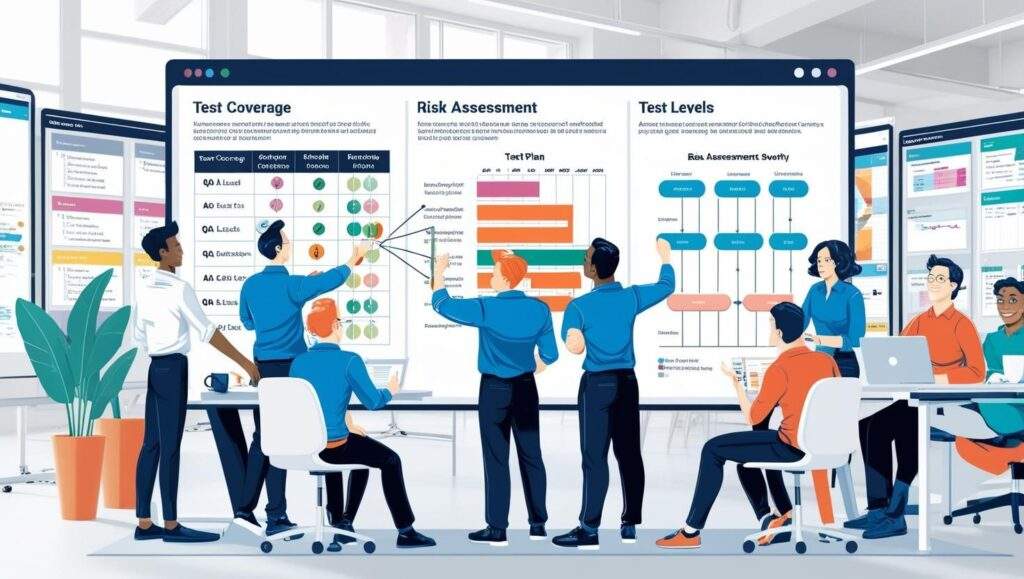
Introduction
A QA Lead’s role extends beyond executing tests—they are responsible for structuring an efficient, scalable testing strategy that ensures quality, coverage, and efficiency across the team. However, many testers transitioning into leadership struggle with defining test strategies and writing test plans effectively.
This post will break down how QA Leads should approach test strategy creation, what makes a test plan effective, and how to align testing with business goals.
1. What is a Test Strategy, and Why Does It Matter?
A Test Strategy is the high-level blueprint that defines:
- What to test (functional, non-functional, security, performance)
- How to test it (manual, automation, exploratory)
- When to test (smoke, regression, sprint-based)
- Who is responsible (QA, devs, product, cross-functional testing)
1.1 Difference Between a Test Strategy and a Test Plan
| Aspect | Test Strategy | Test Plan |
|---|---|---|
| Purpose | High-level approach to testing | Detailed document with test objectives, scope, and execution plan |
| Ownership | QA Lead, Architects, PMs | QA Team, Test Engineers |
| Scope | Organization-wide or project-based | Specific sprint, feature, or release |
| Flexibility | Stable, long-term strategy | Dynamic, updated per sprint/iteration |
Reality Check: While test plans are useful, I usually don’t have them in writing because they often get changed or optimized after one or two sprints depending on the project’s evolving needs. Instead, I focus on building a flexible and adaptable testing framework rather than over-documenting a plan that will be outdated quickly.
That said, I do maintain brief notes outlining the team’s overall responsibilities, ensuring that everyone is aligned. My standard workflow includes:
- Dev finishes feature requests → QA testing
- QA passes verdict:
- If Pass → Dev calls senior dev for code review and merges to staging
- If Fail → QA resets tickets back to development if in scope. Creates bug tickets if Out of Scope
- Once senior dev merges to staging → QA tests staging (regression and E2E)
My test scope for features focuses on the actual Acceptance Criteria (AC), which is why I actively participate in ticket creation. This involvement helps:
- Keep developers focused on the feature, ensuring they work within well-defined requirements.
- Give QA a clear boundary on what to test, preventing unnecessary scope creep and ensuring features get merged to staging without delaying the sprint.
This structured approach helps ensure clear accountability and efficiency without unnecessary documentation overhead.
2. Building a Strong Test Strategy
A great test strategy is tailored to your team’s development process and product goals. Here’s how to build one:
2.1 Define Your Testing Scope
- Identify critical business functions (e.g., payments, authentication, integrations).
- Define must-test scenarios (critical paths, security-sensitive areas, high-risk functionalities).
- Determine what can be covered by automation vs. manual testing.
2.2 Align Testing with Development Workflows
- Waterfall? Agile? DevOps? Adjust test cycles based on release frequency and development methodologies.
- Work closely with PMs and developers to align on sprint goals.
- Ensure testing is not an afterthought—integrate it into the sprint from planning to release.
2.3 Prioritize Test Efforts Using Risk-Based Testing
- High-risk areas (business-critical, high-traffic features) get deep testing.
- Medium-risk areas (core functionalities, backend logic) get moderate testing.
- Low-risk areas (UI consistency, edge cases) get lighter exploratory testing.
Pro Tip: Use a Test Coverage Matrix to ensure high-risk areas have proper test coverage.
3. The Role of a QA Lead in Test Planning
Since I don’t rely on formalized, static test plans, my approach is to focus on adaptability and collaboration. Instead of writing long documents, I ensure:
- Critical test cases and priorities are aligned within the team (covered in sprint planning).
- Exploratory and risk-based testing gets regular iterations (adjusted based on findings from previous sprints).
- Automation and regression suites evolve dynamically (based on product stability and feature changes).
- Defect-tracking and lessons learned drive ongoing improvements (rather than rigid plans).
This approach allows me to stay lean, optimize test efforts based on real feedback, and quickly pivot without being bogged down by unnecessary documentation.
4. Common Pitfalls in Test Strategy & Test Planning
- Overcomplicating Test Plans – Keep them structured but not bloated.
- Not Updating Test Plans – Keep them relevant per sprint/release.
- Focusing Too Much on UI Automation – Balance API, integration, and exploratory testing.
- Lack of Collaboration – Ensure developers, PMs, and business teams understand and contribute.
Conclusion
A QA Lead must design test strategies that are scalable, maintainable, and aligned with business goals. Instead of rigid, static test plans, I rely on an adaptive, evolving strategy that aligns testing with development workflows and business priorities.
By focusing on risk-based prioritization, clear documentation, and collaboration with developers and PMs, QA Leads elevate testing beyond execution and into a strategic, business-critical function.
Coming Up Next: The Art of Giving and Receiving Feedback: Building Strong QA Teams – Learn how QA Leads foster team growth and collaboration through structured feedback loops.

